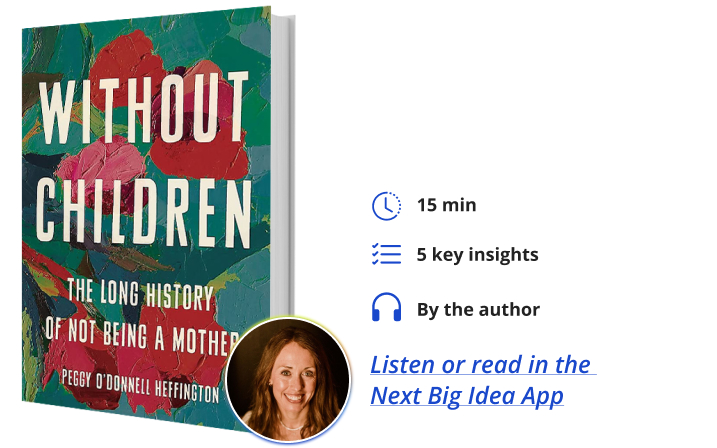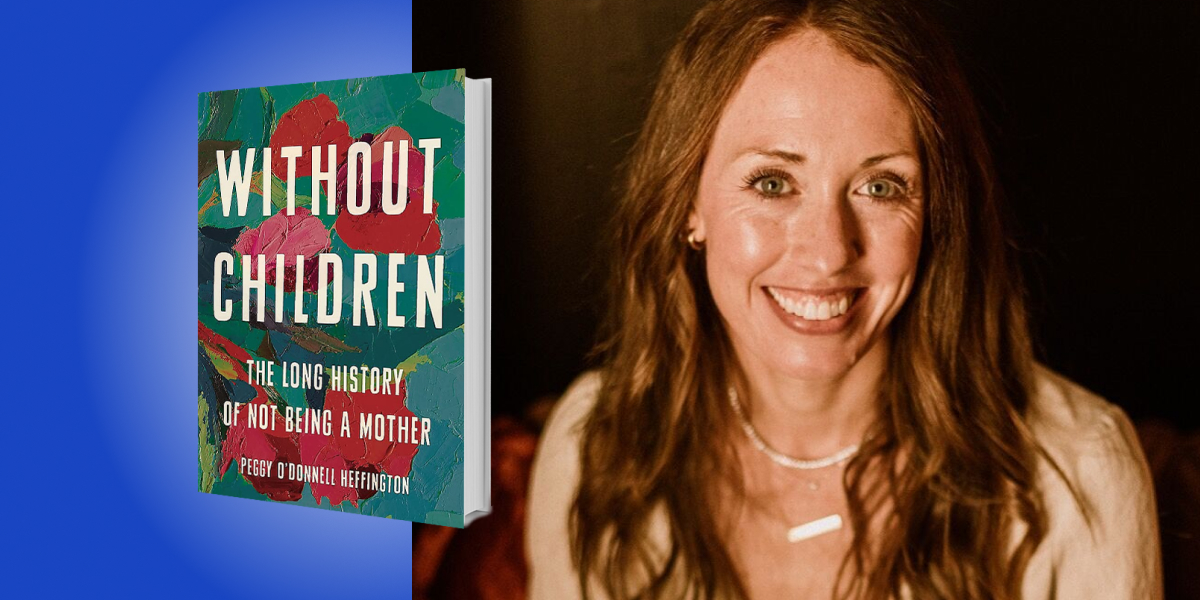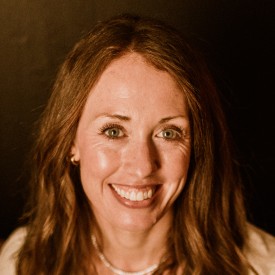Peggy O’Donnell Heffington is an Assistant Instructional Professor in the Department of History at the University of Chicago.
Below, Peggy shares 5 key insights from her new book, Without Children: The Long History of Not Being a Mother. Listen to the audio version—read by Peggy herself—in the Next Big Idea App.

1. There have always been women without children.
Early on, multiple people asked how I could be writing a “long history” of not having children seeing as hormonal birth control was invented in the 1950s. American women had access to legal and safe abortions for only about two generations, from Roe v. Wade in 1973 to the Dobbs decision in 2022. They asked me if I was writing a history of nuns, spinsters, and infertility.
Well, it turns out that there have always been women without children. More specifically, people have been controlling their reproduction long before the invention of the pill or the IUD. Recipes for abortives and contraceptives go way back in history. The ancient Greeks and Romans and medieval Germans and colonial Americans all knew of things that would prevent or end pregnancy at least some of the time. In northwestern Europe since the early modern period, it’s been the norm for one in five women to have no children at all. Some of them may have suffered from infertility. Some of them may have avoided heterosexual sex. But not all of them.
One person I write about is Madame Restell. She was an abortion provider in New York City for over 40 years, from the 1830s to the late 1870s. Restell’s career overlapped the period in American history when abortion went from completely legal (so long as it was performed before quickening, the moment the mother first feels the fetus move) to completely illegal. Connecticut was the first state to criminalize abortion after quickening in 1821; New York followed suit in 1845. But Restell’s business flourished after 1845, even though the services she offered were illegal. She provided contraception and abortion-causing pills to women across the city for three more decades. Women were seeing Madame Restell at great legal risk, and they were seeing less talented professionals often at great risk to themselves—people who might give them pieces of wire to insert into their uteruses or prescribe poisons that might kill them. Yet, they took those risks to exercise control over their reproduction.
There’s this belief on some parts of the political spectrum that if you make abortion illegal or contraception harder to access then people will magically stop trying to control their reproduction. History shows that’s not at all the case: there have always been reasons not to have a child, and women have always sought ways to prevent or terminate pregnancy, whether or not it was safe or legal.
2. The reasons women didn’t have children in the past are not so different today.
The number of babies born in the United States has dropped every year for nearly a decade, and millennials seem to be heading for the highest rate of childlessness in American history. Everyone—from politicians to journalists to grumpy relatives at Thanksgiving—is asking, why are today’s young women not having children?
“Modern life has made it seem harder than ever to have kids.”
Surveys asking young women this question show consistent answers: they don’t have the support networks, money, or jobs that would make children possible; they’ve experienced infertility, and treatments like IVF are either too expensive or haven’t worked; they worry about the effects climate change will have on their children; they just simply want lives that prioritize other things.
Women in the past weren’t so different. They didn’t have children because they lacked community support (in French colonial Canada, for example, historians have shown that the further a woman moved from her family of origin, the fewer kids she was likely to have). They struggled to balance work and children. They experienced infertility, worried about the natural environment their children would be raised in, or they wanted lives that didn’t conform to expectations. Many nuns in medieval Europe became nuns out of genuine devotion, some became nuns because they were seeking an alternative to a traditional life as wife and mother.
The big difference between women of today and the past is that modern life has made it seem harder than ever to have kids, even for those who might otherwise have done so.
3. Choice has always been more complicated than we think.
I can trace the origin of the book to my personal experience of moving from Berkeley, California, where I had just finished my Ph.D., to the United States Military Academy at West Point, where I had a postdoctoral fellowship. I was 29 and while at Berkeley I didn’t know anyone who was thinking seriously about having kids anytime soon. Children seemed like a luxury—in time, money, and emotional resources—that I couldn’t imagine most of us could possibly afford. But then West Point was, as one colleague put it to me, “one huge toddler birthday party.” Women my age had two or three kids.
This contrast got me thinking about the material, financial, and societal circumstances that make it possible for people to parent—and the ones that make it impossible. I realized that this didn’t really fit with how we normally talk about having children: as a choice that individuals opt into or out of consciously and freely. We often assume people without kids just didn’t want them. But for a lot of women without children, it wasn’t that simple. Tons of factors—economic, historical, environmental, personal—expand or constrain the possibility of parenthood. For some people without children, today and in the past, what we call a choice really didn’t feel like a choice.
“We often assume people without kids just didn’t want them.”
For example, women in their fertile years during the Great Depression had the highest rate of childlessness in American history: 20 percent. One in three Black women in that cohort—who were dealing with the economic collapse as well as legalized racism—never had children. Two decades later, childlessness fell to almost nothing during the baby boom, which coincided with the most generous social welfare programs in American history.
Choosing to have a child or not is important, but history also shows us that the context of that choice is equally important.
4. The challenges of parenting are a big part of why women opt out of motherhood.
The COVID-19 pandemic showed how difficult it is to parent in the United States today. Increasing demands of work, increasing costs of housing and childcare, and the lack of parental leave, sick time, and vacation have all contributed to the immensely heavy burden parents, and mothers in particular, carry. Many of the reasons that make it difficult to parent—lack of support, money, and time—are the same reasons many women give when they say they don’t plan to have children at all.
5. The divide between mothers and women without children wasn’t always so wide—and doesn’t need to be.
John Hancock, the Declaration of Independence signatory and founding father, was raised by his childless aunt and uncle, Lydia and Thomas Hancock. John’s father died when he was a kid, and his mom fell on hard times, so she sent John to live with his aunt and uncle. They raised him, sent him to Harvard, and made him their heir. When his uncle died, John Hancock inherited a huge fortune and his uncle’s massive shipping firm, making him one of the wealthiest and most powerful men in the American colonies. Lydia lived with him in his Beacon Hill mansion until the end of her life.
“Remembering our shared history can help us envision a future where we offer mothers networks of support and involve non-mothers in raising the next generation.”
This story is exceptional—most people didn’t inherit enormous fortunes from their uncles—but Lydia Hancock, and the way she took on the role of a mother without having or even formally adopting a child, was not so exceptional. Childless women in the way we think of them today, as fundamentally different than mothers and having made decisions to live a totally different kind of life than moms did, was not in social consciousness one and a half or two centuries back. Social motherhood was a huge part of life: in the American colonies, children were passed from homes that had many children into homes that had few or none; women without children of their own played critical roles in helping their sisters and neighbors raise their biological children. There is a long history of women not having children, but childlessness as a stark marker of identity and social role is relatively new.
By his eighth birthday, John Hancock had two women who were mothers to him in different ways: one that gave birth to him, and one doing the mothering. Indigenous communities in North America were structured around kinship networks of women who raised their children collectively. For Black Americans, caring for children whose parents had been taken from them—whether by slavery, mass incarceration, or other forms of institutional racism—has long been a form of community survival and resistance. In the past, women gave birth, became mothers, and raised their children alongside other women, not all of whom had biological children of their own, but most of whom served, at least temporarily, as someone’s mother.
Today, so much of the divide between moms and non-mothers comes down to having lost the community support that once would have bound us together: overwhelmed moms feeling alone against the world (with cause!) and non-mothers (also with cause!) feel shut out of the project our society values most. Remembering our shared history can help us envision a future where we offer mothers networks of support and involve non-mothers in raising the next generation.
To listen to the audio version read by author Peggy O’Donnell Heffington, download the Next Big Idea App today:































